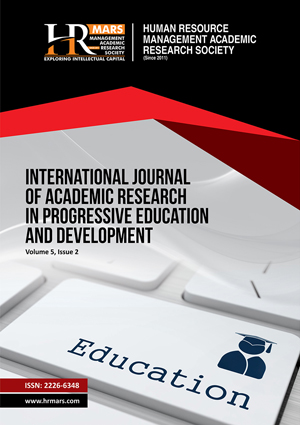
ISSN: 2226-6348
Open access
Happiness is a fundamental goal of life for every individual, regardless of their background or way of life. This study examines happiness from an Islamic perspective, in which elements of happiness and job satisfaction contribute to the formation of faith, morality, and life satisfaction—serving as indicators for daily living. These elements include inner peace, piety, knowledge, practice, morality towards Allah SWT and oneself, cheerfulness, optimism, trustworthiness, and honesty. While previous studies have explored happiness and job satisfaction, many have done so without considering the Islamic viewpoint, focusing only on external aspects. Therefore, this study investigates elements that align with current realities faced by female Islamic Education Teachers (GPI) to serve as guidance and indicators of happiness, which may cultivate individuals and communities that are joyful and excellent. Data obtained from the distributed questionnaires show several factors that contribute to happiness and satisfaction in daily life.
Abdul Aziz, A. R., Abdul Rani, A., Soffian Lee, U. H., Mahyuddin, M. K., Abidin, I., & Mat Jusoh, M. S. (2021). Konsep dan perspektif tauhidik dalam meningkatkan kebahagiaan kendiri. International Journal of Humanities Technology and Civilization (IJHTC), 10(1), 64–79.
Al-Ghazali, A. H. M. M. (1976). Kimya’us Saadah (Kimia Kebahagiaan) (Terj. Abdul Majid Hj. Khatib). Pustaka Aman Press Sdn. Bhd.
Al-Ghazali, A. H. M. M. (1980). Ihya Ulumuddin (Jld. 4). Menara Kudus.
Al-Ghazali, A. H. M. M. (1988). Ihya Ulumuddin (Terj. H. Ismail Yakub). Victory Agency.
Arbuckle, J. L. (2005). SPSS Amos 6 user’s guide. Amos Development Corporation.
Al-Attas, M. N. (1976). Faham agama dan asas akhlak. Angkatan Belia Islam Malaysia.
Ateerah, A., & Lukman, Z. (2019). Happiness instrument development. International Journal of Research and Innovation in Social Science (IJRISS), 3(4), 288–292.
Babbie, E. (2009). The practice of social research. Wadsworth Publishing.
Diener, E. (2005). Understanding scores on the satisfaction with life scale. [Unpublished manuscript].
Hamka. (1990). Tasawuf moden. PT. Pustaka Panji Mas.
Ibrahim, N. N., Ahmad, E. M., Abdul Aziz, R., & Kamaluddin, A. (2018). Factors contributing to students’ satisfaction in blended learning. e-Academia Journal, 8, 139–146.
Ibn Miskawayh. (1968). The refinement of character (T. A. Ibn Muhammad Miskawayh’s Tahdib al-akhlaq). American University of Beirut.
Kartini, W. M., & Matore, M. E. @ E. M. (2020). Analisis instrumen pengukuran kebahagiaan guru: Sorotan literatur bersistematik. Malaysian Journal of Social Sciences and Humanities (MJSSH), 5(10), 184–199. https://doi.org/10.47405/mjssh.v5i10.514
Kartono, K. (2009). Psikologi abnormal dan abnormalitas seksual. Mandar Maju.
Lokman, M. T., & Chua, L. K. (2008). Keperluan latihan berbentuk kursus untuk guru besar [Tesis Sarjana, Universiti Teknologi Malaysia].
Hanapi, M. H. M., Komari, M., & Zakaria, N. (2020). Kesediaan guru pendidikan Islam dalam pelaksanaan pembelajaran abad ke-21. International Journal of Education and Pedagogy (IJEAP), 2(2). http://myjms.moe.gov.my/index.php/ijeap
Sari, N. S. E. P. (2018). Indikator kebahagiaan (al-Saadah) dalam perspektif al-Quran dan hadis. Psikologika: Jurnal Pemikiran dan Penelitian Psikologi, 23(2), 91–108. https://doi.org/10.20885/psikologika.vol23.iss2.art2
Ramli, N. (2016). Prestasi guru pendidikan Islam berasaskan daya kekuatan dalaman, kepimpinan pengetua dan iklim sekolah [Tesis PhD, Universiti Malaya].
Yahya, N., Syed Omar, S. H., & Othman, M. S. (2017). Konsep kepuasan diri menurut Al-Ghazali dan Maslow: Satu kajian perbandingan. Proceedings of International Conference of Empowering Islamic Civilization. http://www.inspire.unisza.edu.my
Ertuck, R. (2021). The relationship between school administrators’ supportive behaviors and teachers’ job satisfaction and subjective well-being. International Journal of Contemporary Educational Research, 8(4), 184–195.
Jose, S. A., & Matore, M. E. @ E. M. (2021). Tinjauan literatur bersistematik: Faktor burnout dalam kalangan guru. Malaysian Journal of Social Sciences and Humanities (MJSSH), 6(1), 168–186.
Abdul Jalil, S. J., Yusmini, Y., & Rozmi, R. (2017). Pembinaan konsep kendiri dari perspektif Barat dan Islam. Jurnal Usuluddin, 45(1), 1–26.
Abdullah, S., & Hussin, H. (2012). Ekspektasi antara hasrat dan realiti wanita bekerjaya terhadap pengurusan kekeluargaan: Kajian di Universiti Malaysia Perlis. Journal of Human Development and Communication, 1, 107–127.
Sofia, N., & Sari, E. P. (2018). Indikator kebahagiaan (Al-Sa’adah) dalam perspektif Alquran dan hadis. Psikologika: Jurnal Pemikiran dan Penelitian Psikologi, 23(2), 91–108.
Sarmadi, S. (2018). Buku psikologi positif. Penerbit Titah Surga.
Qutb, S. (2002a). Dir?s?t Isl?miyya. Dar al-Suruq.
Wu, Z. (2020). How a top Chinese university is responding to coronavirus. World Economic Forum. https://www.weforum.org/agenda/2020/03/coronavirus-china-the-challenges-of-online-learning-for-universities/
Daud, Z., & Sulaiman, M. (2019). Pemikiran Prof. Dato Dr. Haji Awang Sariyan terhadap konsep al-falah dalam akal budi Melayu. E-Prosiding Seminar Tamadun, Etnik dan Turath Islami (i-STET 2019), 252–262.
Rashed, Z. N., Hamzah, H., Zakaria, N. S., & Sani, K. (2021). Cabaran dan strategi pengajaran guru Pendidikan Islam di era Revolusi 4.0. Kolej Universiti Islam Antarabangsa Selangor.
Zulkarnain. (2019). Kesehatan mental dan kebahagiaan: Tinjauan psikologi Islam. Jurnal Dakwah dan Pengembangan Sosial Kemanusiaan Mawa’izh, 10(1), 18–38.
Elias, Z. A., Ajmain@Jima’ain, M. T., & Saari, Z. (2025). Happiness Indicators of Female Islamic Education Teachers Regarding Job Satisfaction According to the Islamic Perspective. International Journal of Academic Research in Progressive Education and Development, 14(2), 240–251.
Copyright: © 2025 The Author(s)
Published by HRMARS (www.hrmars.com)
This article is published under the Creative Commons Attribution (CC BY 4.0) license. Anyone may reproduce, distribute, translate and create derivative works of this article (for both commercial and non-commercial purposes), subject to full attribution to the original publication and authors. The full terms of this license may be seen at: http://creativecommons.org/licences/by/4.0/legalcode